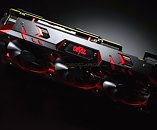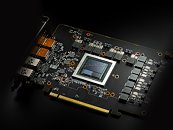Friday, November 17th 2017

PowerColor Radeon RX Vega Red Devil Teased
PowerColor teased its first Radeon RX Vega series graphics card, under its flagship Red Devil branding. The company could use this common board design for both RX Vega 64 and RX Vega 56 SKUs. It combines a custom-design, triple-slot, triple-fan cooling solution, with a semi-custom design PCB. The cooler is an upscale of the company's RX 580 Red Devil, with a massive 2.5-slot thick aluminum fin-stack heatsink, which draws heat from the "Vega 10" GPU and a base-plate conveying heat from the VRM MOSFETs surrounding it, ventilated by a trio of 100 mm fans.
PowerColor's PCB for this card is a variation of AMD's reference "Vega 10" board, in that it's slightly taller towards the front. The company went with two each of DisplayPort and HDMI connectors, instead of the standard three DP + one HDMI layout. The VRM is the same 12-phase setup from the reference-design PCB, with PowerColor sticking to International Rectifier IR6894 and IR6211DirectFETs, and IR3598 phase-doublers, while customizing the chokes. The PCB is enlarged height-wise to give easy access to the BIOS switch. Two inverted 8-pin PCIe power inputs are located toward the end. Given how heavily this board is based on the reference PCB, it remains to be seen if fan idle-power off is featured. PowerColor is expected to launch the RX Vega 64 Red Devil and RX Vega 56 Red Devil before Holiday.
Source:
VideoCardz
PowerColor's PCB for this card is a variation of AMD's reference "Vega 10" board, in that it's slightly taller towards the front. The company went with two each of DisplayPort and HDMI connectors, instead of the standard three DP + one HDMI layout. The VRM is the same 12-phase setup from the reference-design PCB, with PowerColor sticking to International Rectifier IR6894 and IR6211DirectFETs, and IR3598 phase-doublers, while customizing the chokes. The PCB is enlarged height-wise to give easy access to the BIOS switch. Two inverted 8-pin PCIe power inputs are located toward the end. Given how heavily this board is based on the reference PCB, it remains to be seen if fan idle-power off is featured. PowerColor is expected to launch the RX Vega 64 Red Devil and RX Vega 56 Red Devil before Holiday.


18 Comments on PowerColor Radeon RX Vega Red Devil Teased
Only 2 8 pin power inputs? Powercolor had a chance to raise the bar and beat Sapphire by putting 4 in. :roll:
www.mwrf.com/technologies/handling-heat-rfmw-circuits
www.electronics-cooling.com/1998/05/conduction-heat-transfer-in-a-printed-circuit-board/
Put simply: if PCBs were efficient heat conductors, the backs of GPUs wouldn't look like thisthrough a thermal camera.